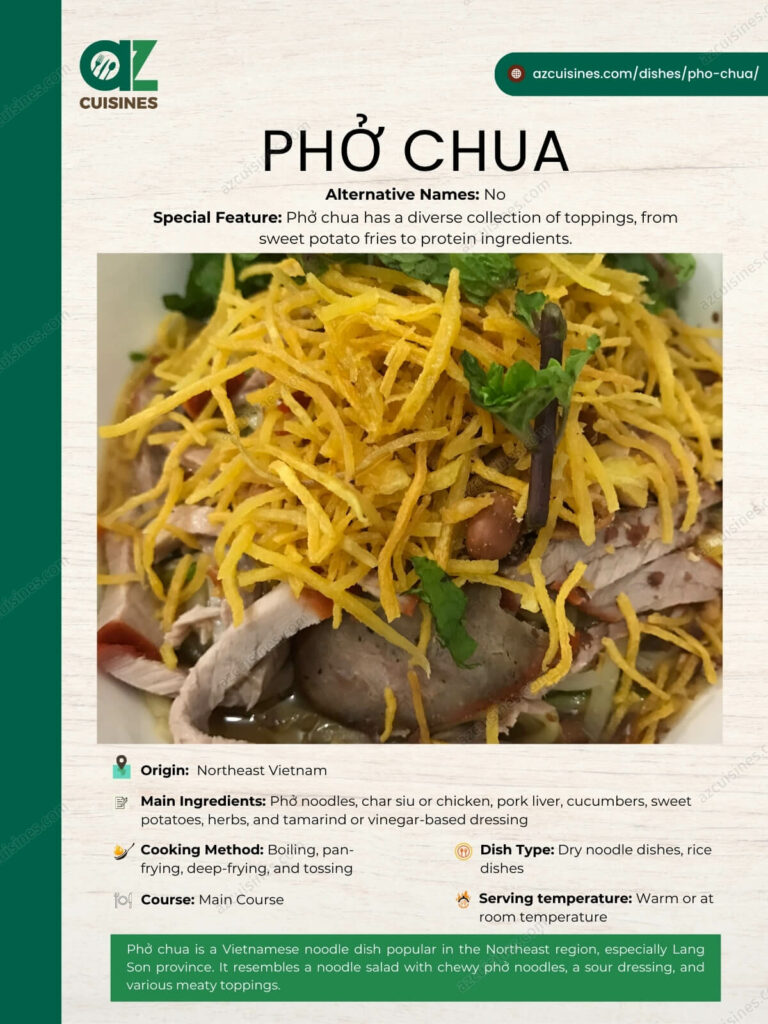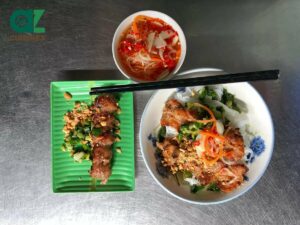Phở Chua (Sour Pho): Basic Information
Pronunciation
Alternative Name(s)
Dish Type
Course
Mealtime
Popular Variations
Phở Chua (Sour Pho): Ingredients and Preparation
Main Ingredients
Main Cooking Method
Preparation Process
- Marinating and pan-frying pork to make char siu
- Making shoestring sweet potato fries
- Making the dressing
- Boiling the noodles
- Assembling phở chua
Phở Chua (Sour Pho): A Deep Dive
Cultural Significance
Taste
Texture
Aroma
Color
Serving Style
Serving Temperature
Accompaniment
- Chili peppers, lime juice, black pepper
- Prawn crackers or fried wontons
- Additional herbs
Occasions
Seasons
Special Diets
Calories
Popularity
Popular Similar Dishes
- Bún Thịt Nướng
- Phở Chấm
- Bún Bò Nam Bộ
- Bún Chả
- Liangpi
- Hiyashi Chūka
- Phở Trộn
Popular Dining Area
Phở chua, literally “sour phở,” is a Vietnamese noodle dish hailing from the mountainous Northeast region. It is a specialty of Lang Son province, but nearby provinces, like Ha Giang and Cao Bang, also offer this exotic delicacy.
Despite the name, phở chua doesn’t have much in common with traditional phở. This noodle dish isn’t served in a broth but rather tossed in a sour sauce or dressing like a noodle salad.
In addition, phở chua uses a different type of rice noodle and features numerous toppings.
There are conflicting theories about the origin of phở chua. Apparently, this Lang Son specialty is either an adaptation of Hanoi-style phở or a culinary borrowing from China, which borders Vietnam in the Northeast region.
Stay tuned for more interesting facts about phở chua, such as its main ingredients, advantages, and disadvantages. I will also cover some frequently asked questions about phở chua and recommend similar dishes,
Key Points
What Is Phở Chua Made of?
Phở chua has the following 4 types of ingredients:
| Ingredients | Description |
|---|---|
| Phở noodles | Smaller, chewier, and sturdier than regular phở noodles |
| Sauce/ Dressing | Made from duck broth (ideally) or water, tamarind or vinegar, fish sauce, soy sauce, oyster sauce, sugar, scallions, ginger, tapioca starch, etc. |
| Toppings | Traditional protein choices: Char siu (Cantonese-style BBQ pork, but made by pan-frying, not roasting), Lạng Sơn roast duck, and fried pork liver Additional protein choices for versions outside Northeast Vietnam: Shredded chicken and chicken offal (intestines and liver) Vegetables: Cucumbers and fragrant herbs Others: Sweet potato shoestring fries, roasted peanuts, pickled papayas, and fried shallots |
| Add-ons | Bird’s eye chili pickled with sliced bamboo shoots The fruit of mắc mật (a local plant known scientifically as Clausena indica) Extra duck broth or roast duck juice Fried pork fat mixed with dried pepper or shacha sauce (used in variations outside Northeast Vietnam) |
While phở chua enjoys a robust flavor profile coming from the diverse collection of ingredients, it also has several shortcomings.
Pros and Cons of Eating Phở Chua
Phở chua has the following upsides and downsides.
Pros
Cons
After presenting you with the strengths and weaknesses of phở chua, I will delve into frequently asked questions about this phở variant.









Truc Tran (Kris)
Senior Food Editor
Expertise
Home Cooking, Meal Planning, Recipe Development, Baking and Pastry, Food Editor, Cooking-video Maker, Vietnamese Food Evaluation Expert
Education
Truc Tran (Kris), an experienced food writer and editor, is great at exploring and describing global cuisines, from simple street food to fancy dining. In her writing, she skillfully mixes different flavors, cooking methods, and culinary traditions, showing the unique character of various cultures through their food and drinks. On azcuisines.com, Kris highlights her knowledge, especially in Asian cuisine and worldwide traditional dishes.